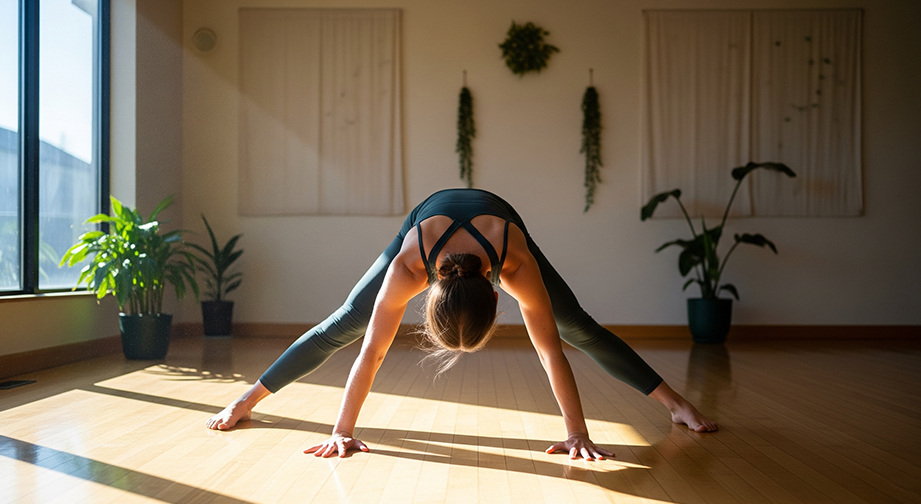Prasarita Padottanasana (Wide Stance Forward Bend): A Complete Guide
Introduction
Prasarita Padottanasana, also known as the Wide Stance Forward Bend, is a peaceful yet invigorating standing yoga pose. The Sanskrit name literally means “wide-legged intense stretch pose.” Its essence lies in providing a deep sense of calm and rejuvenation as you fold forward from a strong, wide stance.
If you’ve ever felt stiff after sitting too long or need a moment to reboot your body and mind, this pose is your best friend. It stretches all those areas that get tight and gives you a fresh perspective—literally and figuratively!
Step-by-Step Guide

- Begin standing at the top of your mat. Step your feet about 3-4 feet apart, making sure your toes point slightly inwards.
- Place your hands on your hips. Take a deep inhale and lengthen your spine upward.
- As you exhale, gently hinge from your hips (not your waist) and begin to fold forward, keeping your back long and chest open.
- Release your hands to the floor underneath your shoulders (use blocks if they don’t reach the ground comfortably). Let your head hang towards the floor.
- With each inhale, find length across your spine. With each exhale, deepen the fold slightly, but never forcing.
- Breathe slowly and hold the pose for 5–10 steady breaths (about 30 seconds to 1 minute). To come up, inhale as you bring your hands to your hips, press down through your feet, and gently rise up, keeping your spine long.
- Beginner modification: Bend your knees slightly or elevate your hands on yoga blocks.
- To intensify: Walk your hands back in line with your feet or hold your big toes/ankles for a deeper stretch.
Alignment & Safety Tips
Key alignment cues:
- Press evenly through both feet and the outside edges.
- Engage your thighs to avoid locking the knees.
- Keep your spine long—avoid rounding your upper back.
- Let your neck relax and gaze softly between your legs or towards the floor.
Common mistakes:
- Rounding the back—focus on lengthening the spine before folding deeper.
- Locking or hyperextending the knees—keep a micro-bend if you’re tight.
- Letting weight fall to the inner arches—ground through the whole foot.
Safety precautions:
- Avoid if pregnant, having recent surgery, or with back/hamstring injuries.
- If you have high or low blood pressure, come up slowly to avoid dizziness.
Benefits of Prasarita Padottanasana
Physical Benefits:
- Stretches hamstrings, calves, hips, and spine
- Strengthens legs, feet, and ankles
- Improves posture and core stability
Mental Benefits:
- Calms the mind and relieves stress
- Encourages a sense of grounding and relaxation
- Builds body awareness and mindfulness
Energy/Chakra Connection:
- Stimulates the root (Muladhara) and sacral (Svadhisthana) chakras for stability and creativity
- Inversions help refresh mental energy
Contraindications
- Pregnant people, those with recent hip, back, or leg injuries
- People with unregulated blood pressure
- Vertigo or glaucoma—opt for a gentle forward fold or seated pose instead
Safe alternatives: Try
Supta Padangusthasana (Reclining Hand to Big Toe) or a gentle
Seated Forward Fold.
Beginners’ Tips & Variations
- Use blocks under your hands for support.
- Try the pose with a bolster or folded blanket under your forehead.
- Wall support: Practice with your back to the wall for stability.
- For a gentle variation, keep your knees bent and focus on lengthening the spine.
- Advanced options: Bring your hands to your ankles, interlace your fingers behind your back, or try a headstand prep from this stance (with experience and guidance).
How to Include Prasarita Padottanasana in a Yoga Flow
- Ideal as a main practice posture, great in the middle or towards the end for stretching and calming.
- Pairs well with: Utthita Trikonasana (Triangle Pose), Parsvottanasana (Pyramid Pose), and Adho Mukha Svanasana (Downward Facing Dog).
Mind-Body Connection
As you hold Prasarita Padottanasana, focus your awareness on the flow of breath down your spine and through your legs. Bring a sense of release with every exhale, inviting mental quiet and a spacious feeling in both body and mind. Energetically, this pose can help you feel more rooted and balanced while inviting creative flow.
Summary Box
Asana Name: Prasarita Padottanasana (Wide Stance Forward Bend)
Level: Beginner to Intermediate
Focus Areas: Hamstrings, calves, spine, hips
Duration: 30 seconds – 1 minute (per round, repeat 2–3 times)
Best Time to Practice: Morning or Evening (avoid on a full stomach)
Frequently Asked Questions
Is Prasarita Padottanasana safe for beginners?
Yes, with blocks and gentle approach! Start slow and listen to your body.
What if my hamstrings feel very tight?
Bend your knees and place your hands on blocks or even a sturdy chair.
Can this pose help relieve back pain?
It may, if practiced gently with a lengthened spine, but avoid if acute injuries exist.
How often should I include this asana in my routine?
2–3 times per week is a great start to build flexibility and awareness.